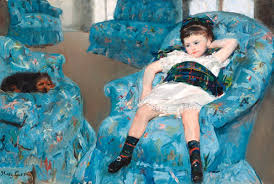Mary Cassatt
Listen to the Recess! Clip
| Author | John Cech |
| Air Date | 5/23/2001 |

Mary Cassatt Transcript
In her famous painting from 1879, of a little girl sprawled on a comfortable blue flowered easy chair, Mary Cassatt, the American Impressionist painter broke nearly all of the rules of portrait painting at the time. Her subject is not carefully or formally posed; in fact, she is slouched so casually into the chair that she seems bored by the whole process of being painted. One hand reaches behind her head, in the way that children who are tired will reach, to rub her neck or to scratch, perhaps, or just to do something while the paint is being dabbed on the canvas and the eternities go by, and she is only, barely holding back a very large yawn. The child, whose name is Suzette and whose uncle is the French painter, Edgar Degas, is nevertheless unimpressed by the presence or the activities of artists. She is almost pouting, and her dark eyes look down and to the side; she is far away in her own world and dangles her legs over the edge of the cushion, which she has probably kicked absentmindedly, and she has surely sighed, loudly and quite audibly a number of times during the sitting. Even the little brown dog, Nipper (actually Mary Cassatt’s dog) has curled up on the chair opposite Susette and gone to sleep.
These scenes of quiet domestic life, and especially of children — at the beach, red-cheeked, intent over shovel and pail, or taking baths, or being nursed, or simply held by their adoring mothers — are the signature subjects of Mary Cassatt, whose birthday it is this week. The people she painted in Paris, during the flowering of Impressionism, in which she would become a central figure, were people she knew — family, friends, friends of friends, children of friends. She was the only woman accepted into that magic circle of avant-garde painters who making art history at the time, and she became a tireless advocate for their art, in essence sending Impressionism to America tucked under the arms of her wealthy friends from back home in Pennsylvania who had come to visit her in Paris. She had wanted to be an artist from the time she was a teenager, and she begged her father to let her go to Paris to study when she was a young woman. She stayed there for the rest of her life, even after her eyesight failed and she was no longer able to paint. At the time, in the 1860s, hers was a bold and determined move, but it gave her the freedom she so desperately knew that she needed to create, and it led her to these these tender, luminous pictures that transcend class and place and time.